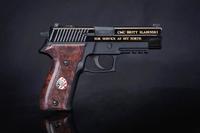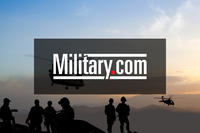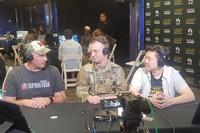LAS VEGAS -- A device created to ease muscle fatigue and cramping while holding a rifle is earning high marks from special operations troops, who say it also makes them more effective downrange.
The Ryker Grip, designed and marketed by a team of Navy and Marine Corps veterans with close ties to the special operations community, uses ergonomics to ease strain on the body, allowing for a more natural head position, squared shoulders, and better body alignment.
The fist-sized piece of military-grade polymer fixes to the rail, allowing shooters to hold and control the gun from the side, rather than from underneath as with a conventional vertical grip.
The design was created by Ron Holmes, a veteran of Force Reconnaissance and Marine Corps Forces Special Operations Command, who found that conventional rifle handling became more taxing as he got older.
Related content:
- Hudson's Innovative H9 Pistol Just Got Lighter and Cheaper
- You Can Now Take a Gun Course from the 'Secret Soldiers' of Benghazi
- Check Out Military.com's Coverage of SHOT Show 2018
"The Marines put a lot of abuse on his body," said Ryker CEO Josh Robertson, a veteran Navy officer. "He was trying to clamp down on a rifle, and his fingers start going numb. So we set out to solve this problem."
They arrived at the concept for a side "fist grip" by trial and error, cutting up existing grips and experimenting with various positions.
"It's honestly that classic garage story. We were just making stuff, whatever we could find, and went through a lot of iterations trying to figure out something that worked," Robertson said. "Eventually, we came to something that worked really well and started playing with it. And we were like, we're actually doing a lot more here than what we thought we were."
They learned, among other things, that the ergonomic position not only made shooters more comfortable; it also made them faster.
The small Ryker team enlisted several statisticians who helped them design a test consisting of a six-round course of fire. They found test subjects maintained accuracy and increased speed by an average of about 12 percent. Among experienced shooters, it was closer to 20 percent, Robertson said.
"We know in a gunfight, seconds count," he said. "You can get a tactical advantage on someone, obviously that's going to increase your survivability ... we can show that yes, this is, in fact, faster. You are more efficient; you do fatigue at a slower rate; you're increasing your odds of surviving a gunfight."
The fist grip also leaves the first and second fingers of a shooter's supporting hand free near the top of the weapon, opening up the potential for new ways to multitask. The company's founders theorize switches could be added to integrate comms or a light, allowing a user to keep both hands securely on the weapon.
"A [Joint Terminal Attack Controller] who's painting a target has to push two switches to do their job while taking it off the rifle," said Jake Joubert, the chief operating officer for Ryker and a veteran Navy officer who worked with special operations. "If we can save a life because somebody's a little bit faster or they maintain a positive control of their weapon, that's really a thing that you can't measure."
The Ryker Grip went on sale in September. At $74.99 each, the company has already sold about 800 of the grips and is working with a growing number of small retailers to distribute them.
They have also sent some downrange through their connections in the special operations community, and have received encouraging feedback.
"The guys love it," an anonymous operator writes in a testimonial on the Ryker USA website. "But don't come back until you have enough for everyone. They keep fighting over the units you sent out."
The Ryker team is working with government distributors and expects the grip to be added to the General Services Administration schedule soon, which will make it easier for military users to buy them.
"It should be very easy for commands that want to purchase them to be able to do so," Robertson said.
While they anticipate initial demand to come from special operations, they see use for the product in law enforcement and even competitive shooting as well.
"What we've really done at its core is created an entirely new category of weapon grips," Robertson said, adding that the company holds two patents on the hand position of the grip. "Eventually, we foresee you'd have a lot of different kinds of Ryker grips. We anticipate there will be an entire product line around this."
-- Hope Hodge Seck can be reached at hope.seck@military.com. Follow her on Twitter at @HopeSeck.










